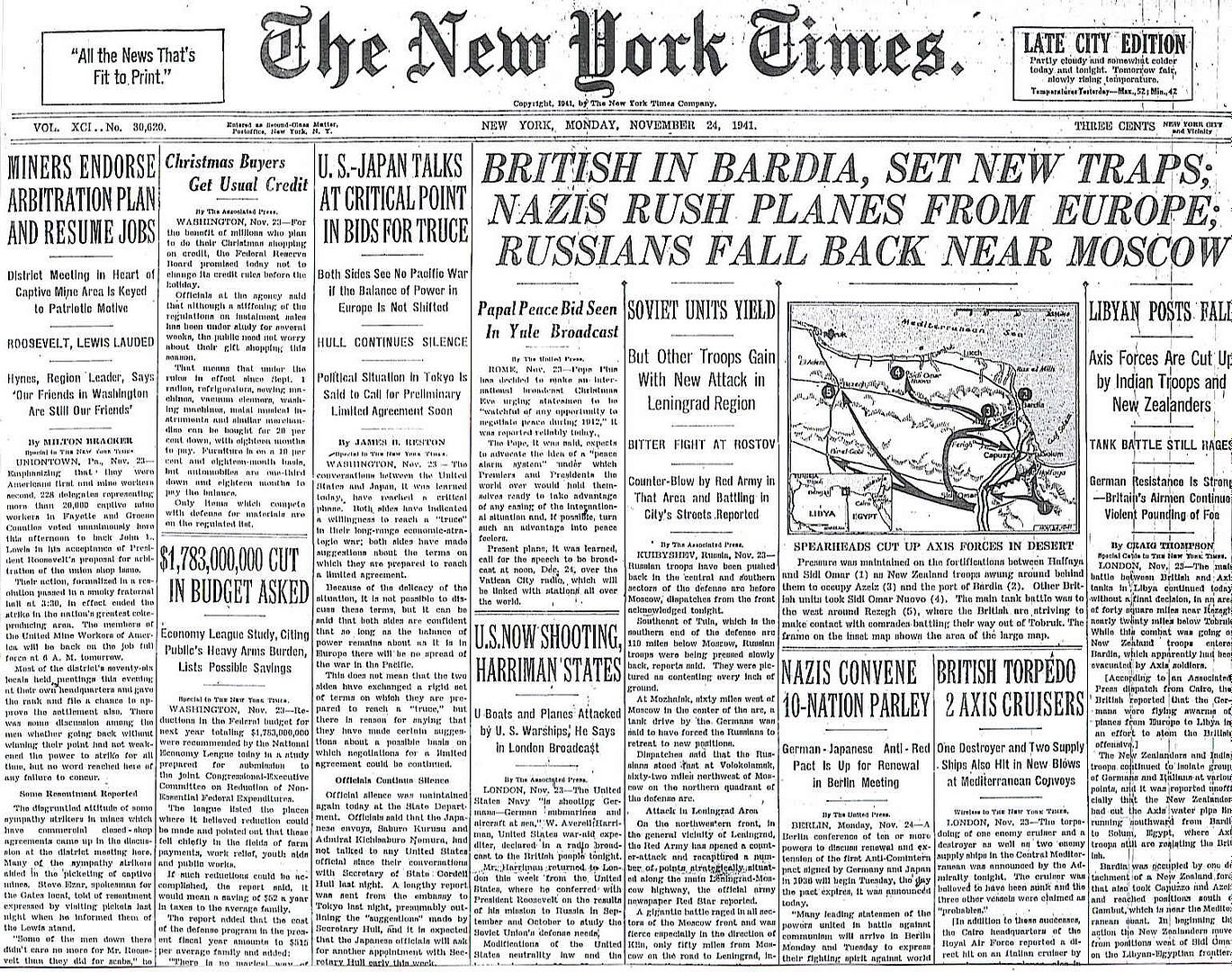
Posted on 11/24/2011 5:47:37 AM PST by Homer_J_Simpson

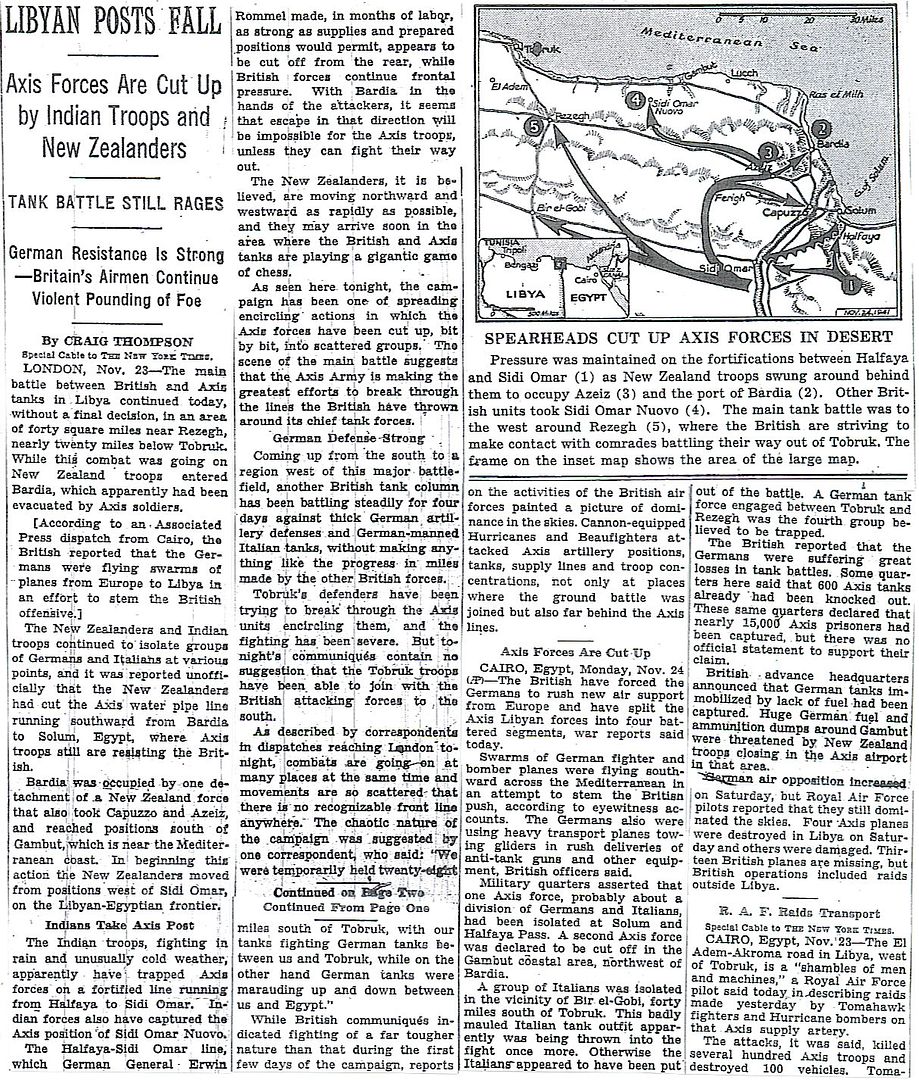
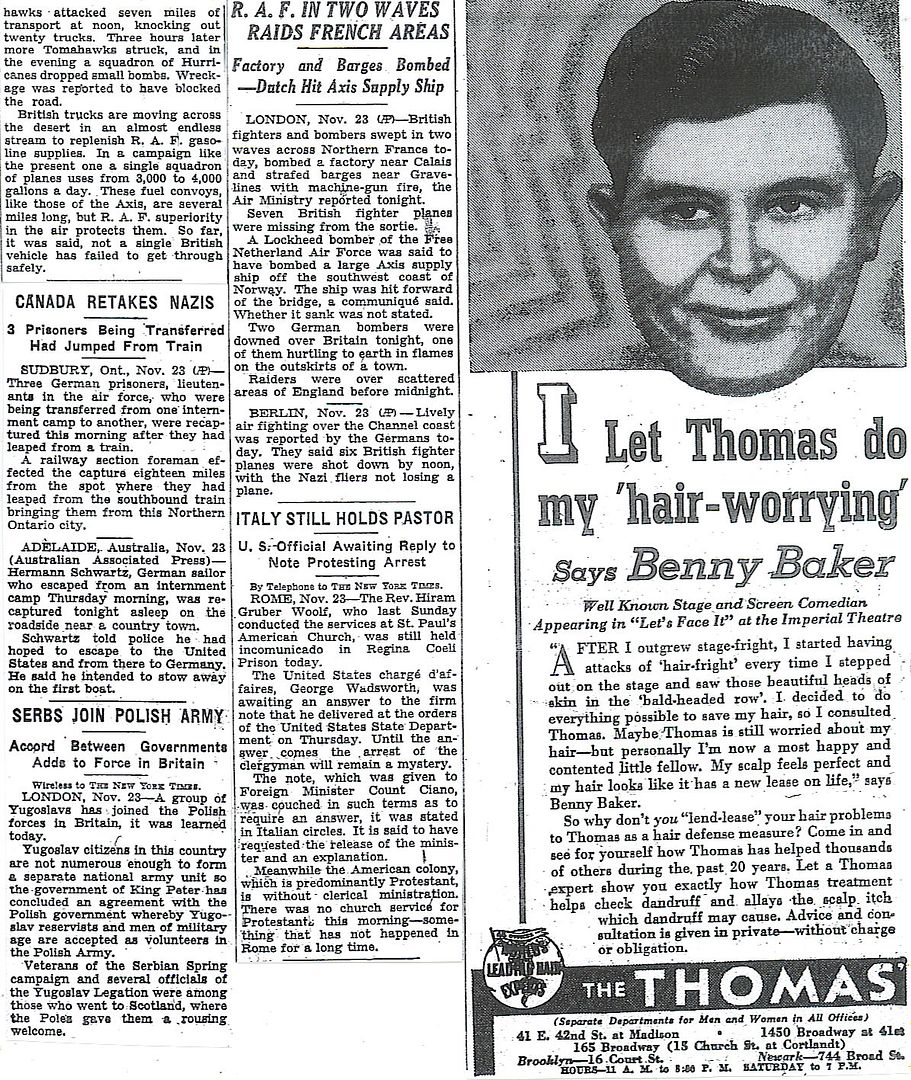
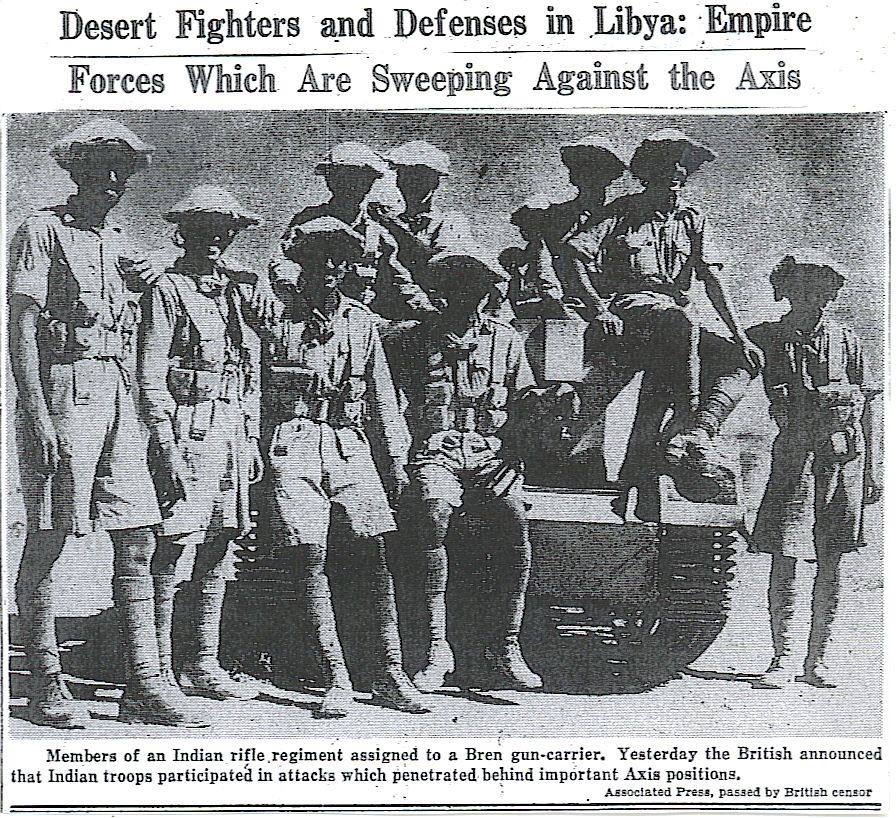
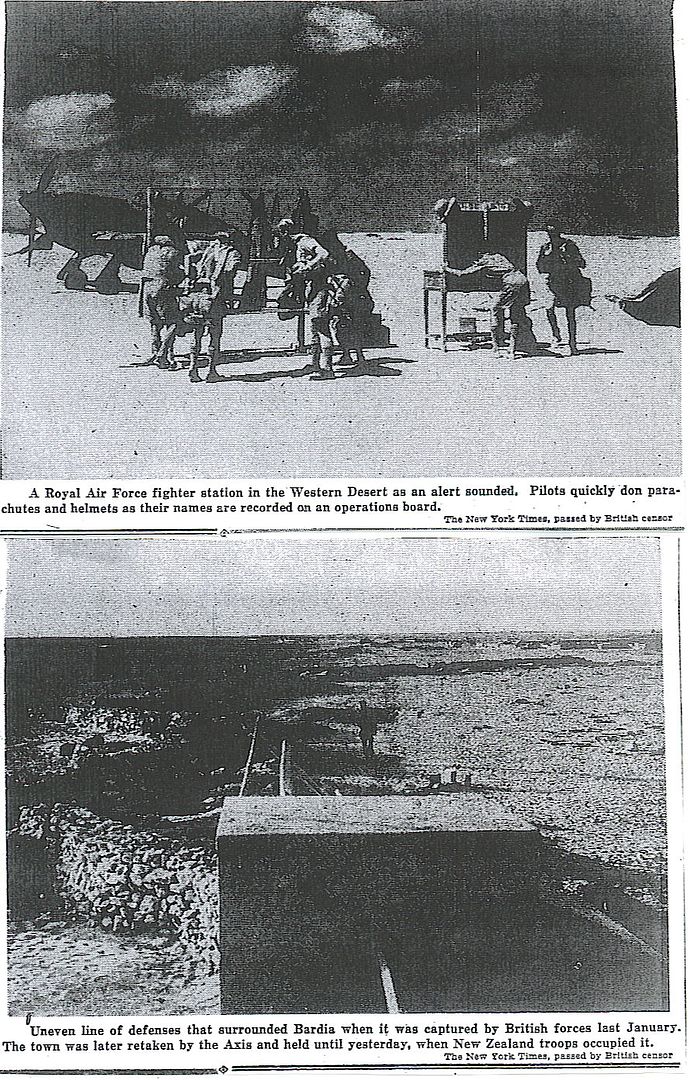
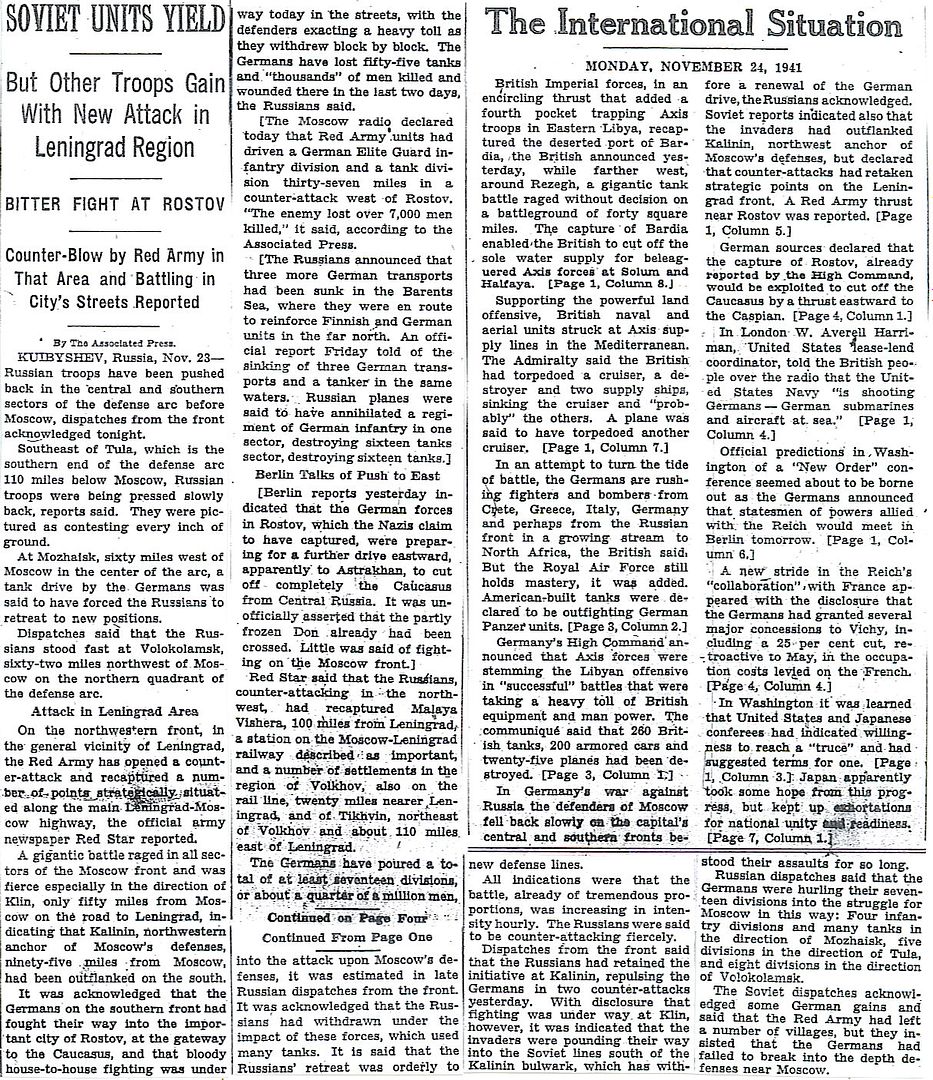
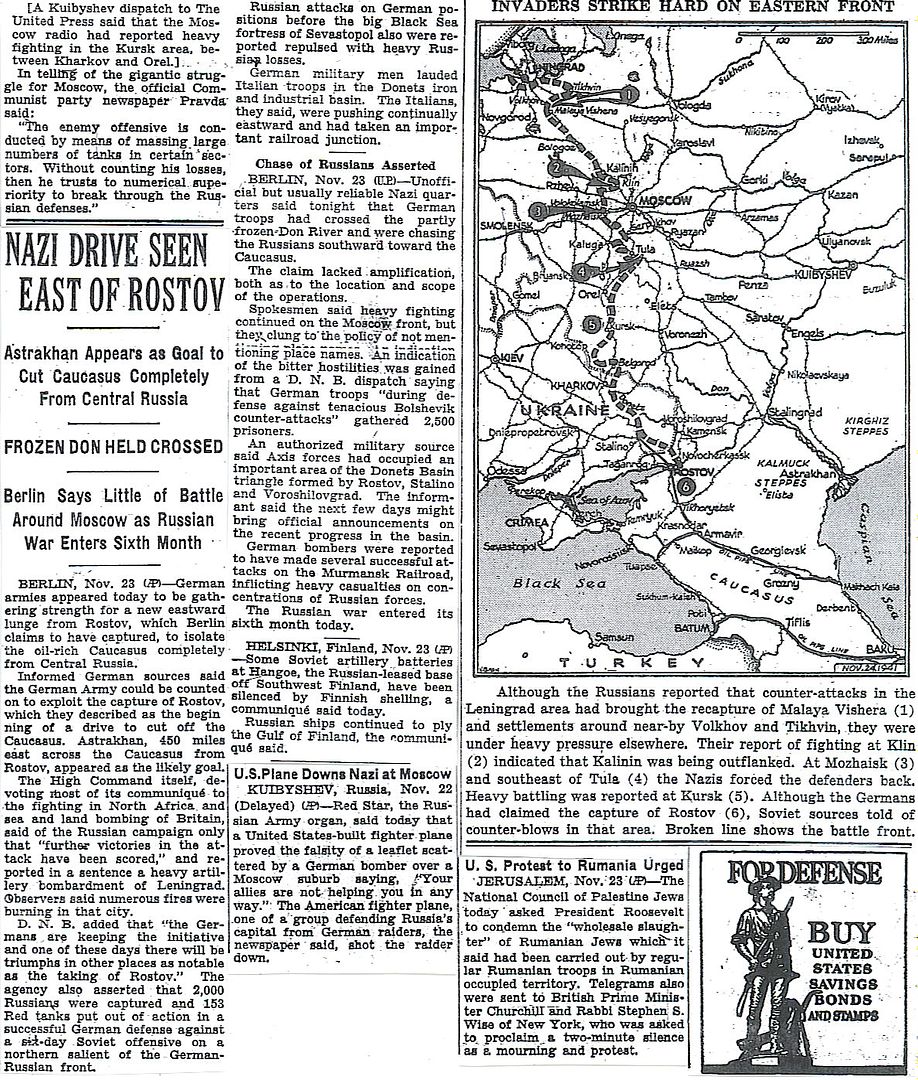
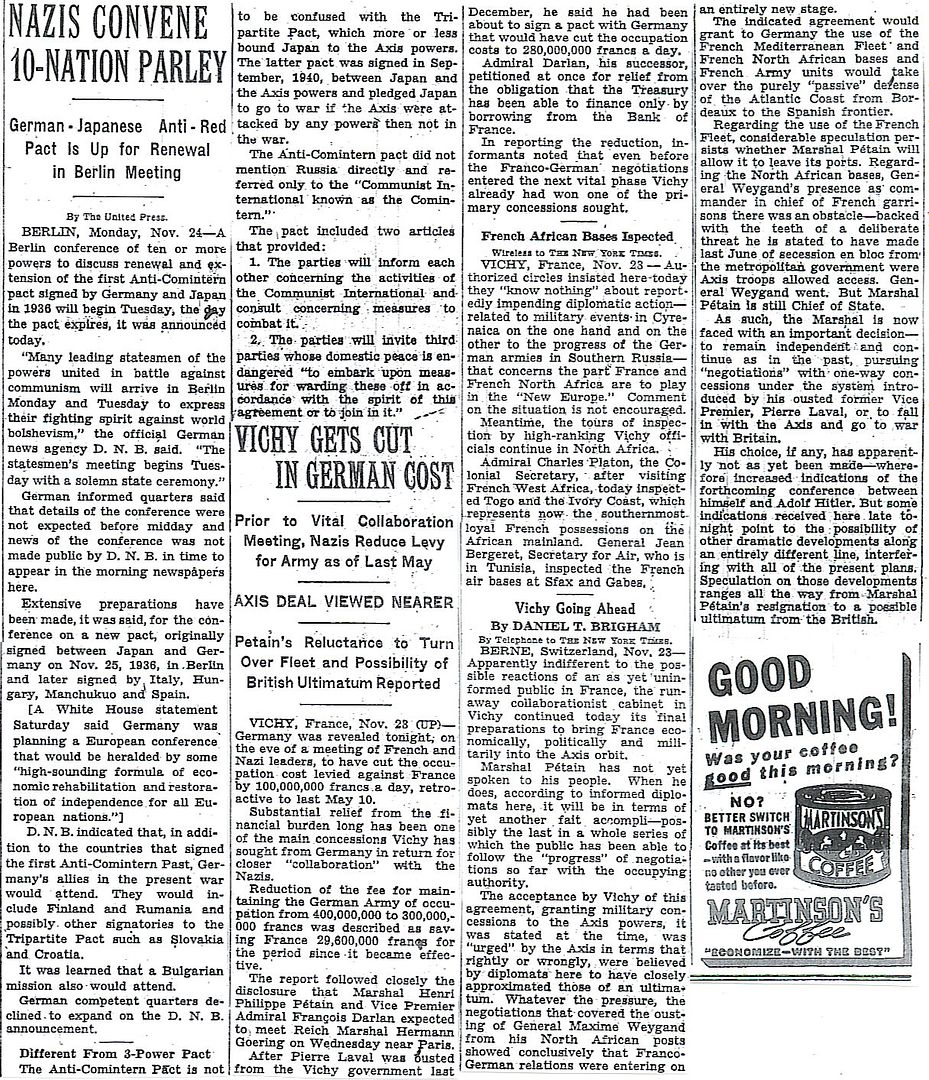
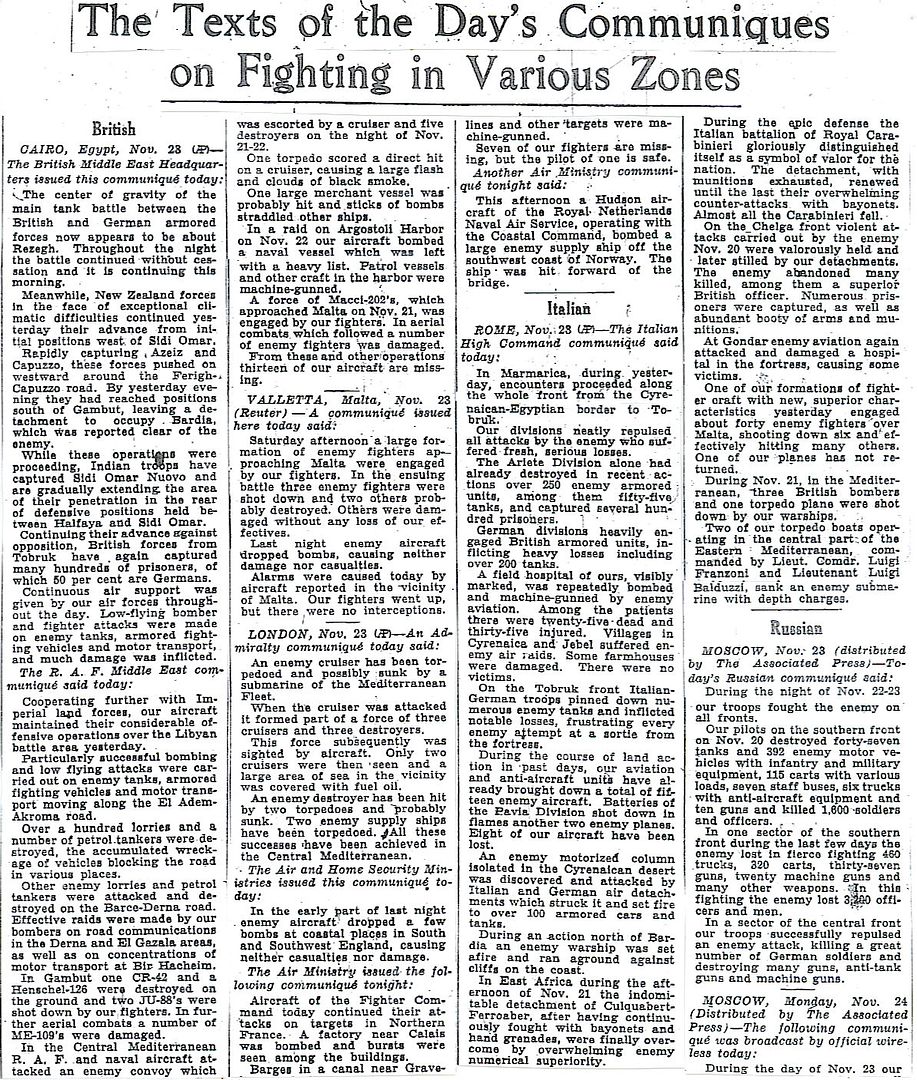
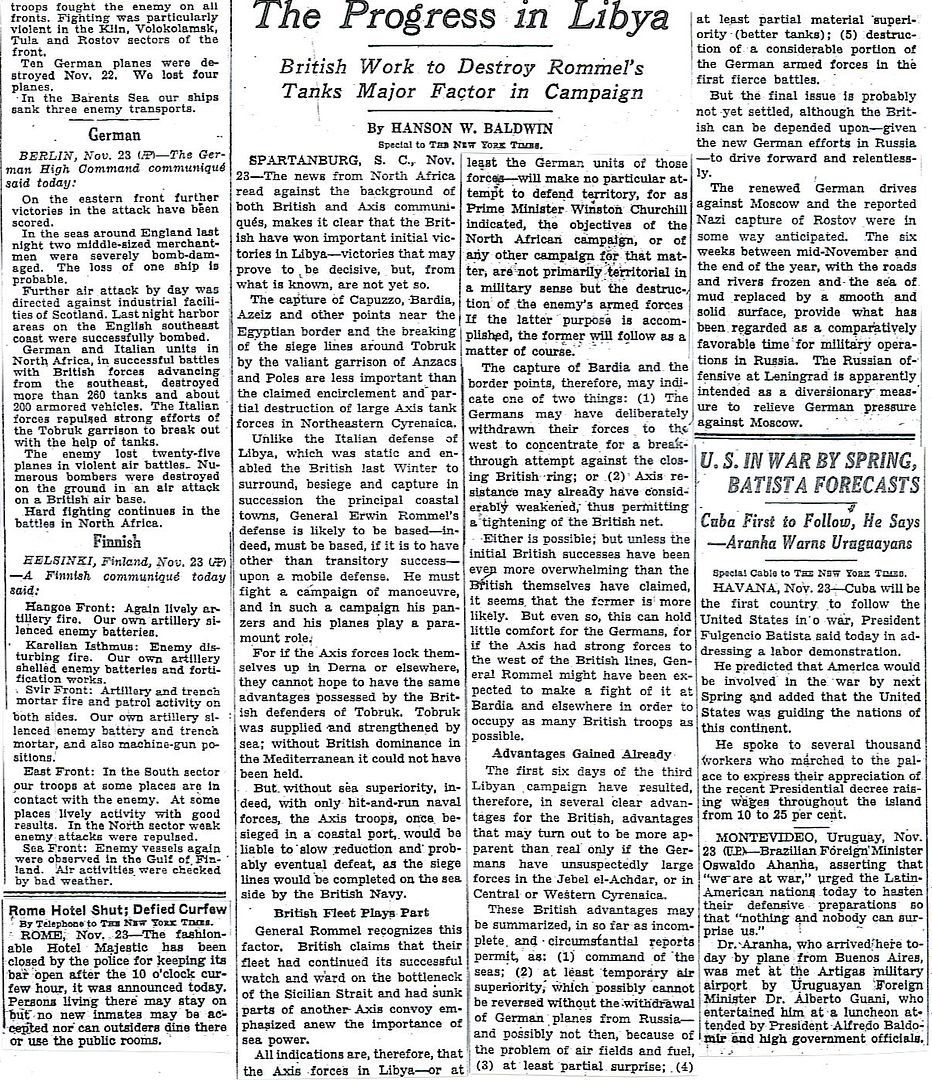
http://homepage.ntlworld.com/andrew.etherington/month/thismonth/24.htm
November 24th, 1941
UNITED KINGDOM: American Lance Wade of 33 Sqdn RAF (and later 145 Sqdn) scores his fifth air to air victory to become an ace. (Skip Guidry)
Minesweepers HMS Mutine and Onyx laid down. (Dave Shirlaw)
During the war, no German prisoner of war escaped from the U.K. Many believe that Luftwaffe Oberleutnant (First Lieutenant or Flying Offiver) Franz Von Werra is the most notable escapee but von Werra made his escape in Canada, where he is sent as a POW. (There were 21 POW camps in Canada.) The most audacious attempt is made by Leutnant Heinz Schnabel and Oberleutnant Harry Wappler today. The two Luftwaffe officers are prisoners in Camp No.15 near Penrith, Northumberland, England, (formally the Shap Wells Hotel). Forging papers that identifies them as two Dutch officers serving in the RAF, they make their way to RAF Carlisle, a flying training base, located 2 miles (3,2 kilometers) north of Carlisle, Cumberland. Without difficulty they enter the station and with the help of a ground mechanic start the engine of a Miles Magister, of which there are 50 parked around the airfield. Taking off, they headed southeast for the North Sea and the Netherlands, a distance of some 365 miles (587 kilometers) to the Dutch coast. Over the North Sea they realize they could not make the Netherlands because the maximum range of a Magister is 367 miles (591 kilometers) on full tanks. Rather reluctantly they decide to turn back and land in a field about 5 miles (8 kilometers) north of Great Yarmouth, Norfolk, England, on the coast. Back at Camp No. 15 again, the two daring escapees are sentenced to 28 days solitary confinement.
GERMANY: Theresienstadt was a town that had housed a Czech military prison going back to the 19th century. 150,000 Jews are deported and transferred to death camps, is established at Terezin, about 90 miles (145 kilometers) north of Prague. It is used to camouflage the extermination of European Jews, by the Nazis who tout it as a “model Jewish settlement.” When the Red Cross visits, dummy stores, cafes, schools and gardens are set up.
U-706 is launched. (Dave Shirlaw)
CZECHOSLOVAKIA: Theresienstadt, a ghetto where 150,000 Jews are deported and transferred to death camps, is established at Terezin, about 90 miles (145 kilometers) north of Prague. It is used to camouflage the extermination of European Jews, by the Nazis who tout it as a “model Jewish settlement.” When the Red Cross visits, dummy stores, cafes, schools and gardens are set up
U.S.S.R.: Rostov is evacuated by the Germans in the face of again being cut off in the rear. Field Marshall Rundstedt make this move in the face of express orders from Hitler to stand fast.
LIBYA: Rommel, believing the British Armour destroyed, ignores the New Zealand Divison and advances along the Trig el Abd to the Egyptian border. During the “Dash to the Wire” Rommel and his senior commanders lose touch, and the British rear echelons panic. The Germans take losses they cannot afford and their hold on the British armour becomes slack.
COMMONWEALTH OF THE PHILIPPINES:
Hart relayed Navy Department message to MacArthur (
NOVEMBER 24, 1941, MESSAGE TEXT (STARK TO HART):
THE CHIEF OF STAFF IS IN AGREEMENT WITH THE ESTIMATE PRESENTED HEREWITH AND REQUESTS THAT YOU INFORM THE SENIOR ARMY OFFICER IN YOUR AREA COLON CHANCES OF FAVORABLE OUTCOME OF UNITED STATES DASH JAPANESE NEGOTIATIONS ARE VERY DOUBTFUL PERIOD THIS SITUATION TOGETHER WITH STATEMENTS OF JAPANESE GOVERNMENT AND MOVEMENT OF THEIR MILITARY AND NAVAL FORCE INTIMATE IN OUR OPINION THAT SURPRISE AGGRESSIVE MOVEMENT IN ANY DIRECTION INCLUDING ATTACK ON PHILIPPINES OR GUAM IS A POSSIBILITY STOP THIS INFORMATION MUST BE TREATED WITH UTMOST SECRECY IN ORDER NOT TO COMPLICATE A TENSE SITUATION OR PRECIPITATE ACTION END STARK).
Quezon stated publicly that Roosevelt and Sayre should be “hanged from lampposts” because of their inattention to Philippine civil defence.
Gerow drafts memorandum to Marshall advocating that “a modus vivendi” be reached with Japan.
Stark sends appeal to FDR to urge him to continue negotiations to allow war preparations to continue.
Time Magazine had Hart on its cover; the article called him “the indispensable oldster.”
(Marc Small)
CANADA:
Patrol vessels HMCS Ehkoli and Leelo commissioned.
HMC ML 051, 056, 072 and 073 commissioned.
Minesweeper HMCS Red Deer commissioned.
Minesweeper HMCS Swift Current arrived Halifax from builder Montreal, Province of Quebec. Employed as ASW training ship. Homeport shifted to Pictou , Nova Scotia in 1942. (Dave Shirlaw)
U.S.A.: Admiral Harold R. Stark, the USN Chief of Naval Operations, sends the following message to Admiral Thomas C. Hart, Commander-in-Chief Asiatic Fleet in the Philippine Islands; Admiral Husband E. Kimmel, Commander-in-Chief Pacific Fleet in the Territory of Hawaii; Rear Admiral Charles A. Blakely, commander of the Eleventh Naval District at San Diego, California; Vice Admiral John W. Greenslade, commander of the Twelfth Naval District at San Francisco, California; Vice Admiral Charles S. Freeman, commander of the Thirteeth Naval District at Seattle, Washington; and Rear Admiral Frank H. Sadler, commander of the Fifteenth Naval District in the Canal Zone: “Chances of favorable outcome of negotiations with Japan very doubtful. This situation coupled with statements of Japanese Government and movements their naval and military forces indicate in our opinion that a surprise aggressive movement in any direction including attack on Philippines or Guam is a possibility.
Chief of Staff (of the U.S. Army, General George C. Marshall) has seen this dispatch concurs and requests action addresses to inform senior Army officers their areas. Utmost secrecy necessary in order not to complicate an already tense situation or precipitate Japanese action. Guam will be informed separately.” (Jack McKillop)
The Government revokes export licenses to French North Africa, Spain, and Tangier “to induce France to refuse open collaboration with Germany. (Jack McKillop)
The U.S. grants lend-lease aid to Free France “for the purposes of implementing the authority conferred upon you as Lend-Lease Administrator by Executive Order No. 8926, dated 28 October 1941, and in order to enable you to arrange for lend-lease aid to the French Volunteer Forces (Free French) by way of retransfer from His Majesty’s Government in the United Kingdom or their allies, I hereby find that the defense of any French territory under the control of the French Volunteer Forces (Free French) is vital to the defense of the United States.” (Jack McKillop)
NETHERLANDS GUIANA: The United States occupied Dutch Guyana [Surinam] in agreement with The Netherlands and Brazil to protect bauxite mines because, “The bauxite mines furnish upwards of 60% of the requirements of the U.S. aluminium industry, which is vital to the defense of the U.S., the western hemisphere and the nations actively resisting aggression”. (Dave Shirlaw)
ATLANTIC OCEAN: On her way to rescue “Atlantis” survivors, U-124 sinks the British cruiser HMS Dunedin, off St. Paul’s Rocks, NorthEast of Recife, Brazil, half way between Africa and South America. The U-boat uses two torpedoes.
Dunedin had been part of a task unit sent to counter a German operation involving four U-boats, an armed merchant raider (Atlantis) and a supply ship (Python) against shipping near Cape Town. The British heavy cruisers Devonshire and Dorsetshire plus Dunedin were ordered to search independently to track down the surface raider. On 22nd November Devonshire came upon Atlantis, which scuttled herself to avoid capture. U-124, Kptlt. Ernst Bauer, Knight’s Cross, CO, which had been engaged in re-supplying from Atlantis at the time, sent an uncoded radio signal that there were survivors in the water. On 24th November, Python came to help U-126, who was towing lifeboats from Atlantis. At the same time, U-124, which was on her way to rendezvous with Python, KKpt. Mohr sighted Dunedin NE of St. Pauls Rocks, 900 miles west of Freetown, just south of the Equator. He fired three torpedoes at extreme range, even though Dunedin was steaming away at 17 knots and was altering course. Two torpedoes hit, an extraordinary accomplishment, the first striking amidships and the second further aft. Dunedin capsized and sank in approximately 17 minutes. About 150 men survived the sinking but had to spend the next seventy-eight hours on Carley Floats. Seventy-two men were rescued in the late afternoon of 27th November by the US Lykes Lines freighter Nishmaha (6,100 GRT), which was enroute to Philadelphia. Five more survivors subsequently died before the ship reached Trinidad. (Dave Shirlaw)
Before there was _ “Das Boot”_ there was “Grey Wolf, Grey Sea” — a stirring account of the exploits of U-124 written by author E.B. Gasaway (Ballantine Books, 1972 ISBN:345-02533-4). Known by the the distinctive ‘Edelweiss’ insignia on her conning tower [*], commanded first by Ritterkreuztraeger Kapitanleutnant Wilhelm Schulz, and succeeded by his IWO Kplt. Jochen Mohr (RK/eichl.); in her short life, (commissioned 11 JUN 1940) U-124 , a type IXB long range boat, sank 49 ships for a total of 232,887 GRT to become the third most successful submarine to have fought in the Second World War. (Russ Folsom)
[*] - The ‘Edelweiss’ insignia was an homage to the German Mountain Troops who helped to rescue the crew of the U-64, strafed and sunk by British aircraft in a Norwegian fijord during ‘Operation Weseruebung’ (the invasion of Norway) in April 1940. The crew of the new U-124 was mostly composed of the ‘old salts’ of U-64. When ‘Kaleu’ Mohr assumed command of the boat in mid-1941, a green bullfrog insignia was also added.
http://www.onwar.com/chrono/1941/nov41/f24nov41.htm
Axis forces racing to Egyptian border
Monday, November 24, 1941 www.onwar.com
In North Africa... General Rommel believing that the British armor has mainly been destroyed in the fighting on the day previous and ignoring the actions of the New Zealand infantry, decides to consolidate his forces and advance along the Trigh el Abd to the Egyptian border. This move becomes known as the “dash to the wire” and it causes some concern in the rear echelons of British 8th Army. The Axis forces take some losses from harrying actions but there are no major engagements.
On the Eastern Front... German forces retreat from Rostov because of the threat to their rear due to the Soviet counterattacks in this area. The withdrawal comes from a personal order from Field Marshal Rundstedt who has been expressly forbidden to do so by Hitler.
In the North Atlantic... The British cruiser, Dundedin is sunk by German U-boat U-124.
"But pray ye that your flight be not in the winter . . ."
The outposts in the sector of 87th Infantry Regiment had just been relieved.
The time was 0500, and it was freezing. The thermometer stood at 25 degrees below zero Centigrade (-13f). The men were trudging through the snow towards the little Yakhroma river. From the chimneys of the peasant cottages in the valley the smoke rose straight into the grey morning. Everything was quiet. The 87th Infantry Regiment belonged to 36th Motorized Infantry Division. The regiments from Rhineland— Hesse were holding the front line between the Volga reservoir south of Kalinin, also known as the Moscow Sea, and Rogachevo. The long sector could be held only in the form of separate strongpoints. For anything else the regiments were too weak. They had been bled white—and, even more so, frozen white.
In a temperature of 30 to 40 degrees below zero Centigrade no man could lie in a forward snowhole for more than an hour. Unless, of course, he was wearing a sheepskin and felt boots, a fur cap and padded gloves. But the men of 36th Motorized Infantry Division had none of these things.
They were within 30 yards of the village. Iced-up, their horse-drawn wagons stood by the stream. The shaft of the village pump rose high above the low roofs. By the pump stood some Russian women, getting water. Suddenly they all started—the pickets who had just been relieved and the Russian women. Instinctively they ducked. They scampered to the nearest cottages. And there it was—the "howling beast." There was a crash, fountains of snow rising into the air, red-hot shrapnel bouncing off the ground, which was frozen as hard as stone. The shell-splinters crashed into the bath-house and shot into the cottages.
Action stations!
The date was 5th December 1941—a Friday. A page was being turned in the history of the war. The great Russian counteroffensive before Moscow was beginning. Here, in the sector of 36th Motorized Infantry Division, in the operations zone of LV1 Panzer Corps, the curtain was rising on a savage and pitiless historical drama.
Twenty-four hours later the great battle began also on the remaining sectors of Army Group Centre —between Ostashkov and Yelets, along a 600-mile front.
What was the situation before Moscow on that 5th December?
North and west of the Soviet capital the German spearheads had got to within a few miles of the outskirts of the city. On the northern wing of Army Group Centre, Ninth Army held a 105-mile arc through Kalinin to the Moscow Sea. The divisions of 3rd Panzer Group, which were to have outflanked Moscow in the north, had advanced as far as Dmitrov on the Moskva—Volga Canal. Farther south were the most forward units of XLI Panzer Corps, poised to cross the canal north of Lobnya. The combat group Westhoven of 1st Panzer Division, having captured Nikolskoye and Belyy Rast, had reached the western edge of Kusayevo. Adjoining on the right, 4th Panzer Group held a quadrant around Moscow, from Krasnaya Polyana to Zvenigorod; the distance to the Kremlin was nowhere more than 25 miles. The combat outposts of 2nd Panzer Division were at the first stop of the Moscow tramway. An assault detachment of Engineers Battalion 62 from Wittenberg had got closest to Stalin's lair by penetrating into the suburb of Khimki, only 5 miles from the outskirts of the city and 10 from the Kremlin.
On the southern wing of Hoepner's 4th Panzer Group, reading from left to right, were 106th and 35th Infantry Divisions, 11th and 5th Panzer Divisions, as well as the SS Motorized Infantry Division "Das Reich," and 252nd, 87th, 78th, 267th, 197th, and 7th Infantry Divisions. Next followed the divisions of Kluge's Fourth Army. They were 30 miles from Moscow, along a line running from north to south, between the Moscow motor highway and the Oka.
Next along the front came Guderian's Second Panzer Army. It had bypassed the stubbornly defended town of Tula and was holding a big eastward bulge around Stalinogorsk; its armored spearhead, the 17th Panzer Division, pointing northward against the Oka, stood before Kashira.
On the extreme right wing the Second Army was covering the southern flank and maintaining the link with Army Group South.
This then was the 600-mile front line along which the German offensive had come to a standstill at the beginning of December—in the most literal sense frozen into inactivity. Men, beasts, engines, and weapons were in the icy grip of 45 and even 50 degrees below zero Centigrade. In the diary of a man of 69th Rifle Regiment, 10th Panzer Division, we find the sentence:
"We are waging the winter war as if this was one of our Black Forest winters back home."
That was the exact truth. Officers and troops lacked suitable special winter clothing to enable them to camp and fight on open ground at temperatures of minus 50 degrees. As a result, they clad themselves in whatever they could lay their hands on, or what they found in Russian textile mills, workshops, and stores—one garment on top of another But this hampered the men's movements instead of making them warm. And these filthy clothes, which were never taken off, were breeding places for lice, which got right into the skin. The men were not only cold, but also hungry. Butter arrived hard as stone and could only be sucked in small pieces as "butter ice." Bread had to be divided with the axe, and then thawed out in the fire. The result was diarrhea. The companies were dwindling away. Their daily losses due to frostbitten limbs and feverish intestinal troubles were higher than those from enemy action.
Like the men, the horses suffered from cold and hunger. Supplies of oats did not arrive. The frozen straw off the cottage roofs no longer satisfied their hunger, but merely made the animals sick. There was a heavy incidence of mange and colic.
The animals collapsed and died by the dozen.
The engines likewise were out of action. There was not enough anti-freeze: the water in the radiators froze and engine blocks burst. Tanks, lorries, and radio vans became immobile and useless. Weapons packed up because the oil froze in the moving parts. No one had thought of making sure of winter oil. There was likewise no special winter paste for the lenses of field-glasses, trench telescopes, and gunsights. The optics froze over and became blind and useless.
Hardly anything was available that would have been necessary for fighting and for survival in this accursed Russian winter. The Fuehrer's Headquarters had thought that the troops would be in Moscow before the onset of the frost. The bill for this bad miscalculation in the operational time-table and the resulting lack of supplies had now to be footed by the men in the field. Why were the needs of the hard-pressed front not met by supplies from Europe?
Because what few locomotives were available likewise froze up. Instead of the twenty-six supply trains needed daily by Army Group Centre, only eight, or at most ten, arrived. And most of the JU-52 supply aircraft were unable to take off from their airstrips in Poland and Belorussia because of the biting cold and the lack of hangars.
Here is a passage from a letter by Lance-corporal Werner Burmeister of the 2nd Battery, 208th Artillery Regiment, a regiment newly arrived from France:It's a hopeless job—you've got six horses harnessed to the gun. The front four can be led by hand, but for the two alongside the shaft some one must be mounted, because unless a man is in the saddle and jams his foot against the shaft it will hit the flanks of the animals at every step. At 30 degrees below, in those tight, nailed jackboots of ours, you get your toes frozen off before you even realize it. There isn't a man in my battery who hasn't got frostbite in his toes and heels.
That was the Russian winter—cruel in an undramatic and trivial way. The Russian troops invariably received leather boots one or two sizes too large, to enable them to be stuffed with straw or newspaper—a highly effective procedure. It was a trick well known also to the old lags in the German Army in the East. But unfortunately for them their boots were the right size. In these conditions, was it surprising that the troops were finished? The combat strength of the regiments was down to less than half. The worst of it was that the Officers' and NCO Corps, as well as the bulk of the old experienced corporals, had been decimated by death in action, by freezing, and by disease. There were lieutenants in command of battalions, and frequently sergeants in command of companies. There were no reserves anywhere. In such conditions Army Group Centre was expected to hold a line over 600 miles long.
All this must be realized in order to understand what happened next.
And what was the situation on the Soviet side?
Even while the German offensive was still gaining ground the Soviet High Command had assembled a striking force south of Moscow and another north of the city. Whatever military reserves were available in the huge country were brought to Moscow. The eastern and southern frontiers were ruthlessly denuded. Siberian divisions, accustomed to winter and equipped for winter warfare, formed the nucleus of these new forces. The Soviet High Command dispatched thirty-four Siberian divisions to its Western Front; of these twenty-one were facing Army Group Centre, which had comprised seventy-eight divisions in October, but which by early December was left with the combat strength of a mere thirty-five. This greatly reduced effective fighting power was thus outweighed by the freshly arrived Siberian units alone.
Their employment proved decisive.
The concentration of Soviet forces before Moscow was the result of what was probably the greatest act of treason in the Second World War.
Stalin knew Japan's intention to attack not Russia but America. He knew it from his agent in Tokyo, Richard Sorge, who, as the trusted colleague of the German Ambassador and the friend of the most highly placed Japanese politicians, was acquainted with the intentions of the German and the Japanese leaders. He reported to Stalin that Japan had refused the German Government's suggestion that she should attack Russia. He reported that the Japanese military were preparing for war against America in the Pacific. Since Sorge's reports about the German offensive intentions in spring 1941 had been so fully confirmed by events, Stalin this time believed the reports from Tokyo and withdrew his entire forces from the Far East to Moscow, even though the Japanese Kwantung Army was poised ready to strike in Manchuria.
But for these dispositions Moscow could not have been saved.
The ultimate proof of the tie-up between Sorge's information and military events is provided by the fact that Stalin opened his offensive around the very time when the Japanese warships set course for Pearl Harbor to start the war against the USA. Even this top-secret date, the date of Japan's attack on America, had been passed on to Stalin by Sorge. And as soon as Soviet reconnaissance aircraft confirmed the Japanese naval deployment Stalin, mistrustful though he was, felt sure that Dr Sorge's information was reliable.
He could now safely employ his Siberians outside Moscow.
At the beginning of December 1941 the Soviet High Command had concentrated altogether 17 Armies for an attack against the German Army Group Centre. Three of these— the First, Tenth, and Twentieth Armies—consisted of Siberian and Asian divisions which had been newly raised. The other Armies, according to the reliable military historian Samsonov, had been "trebled or quadrupled by the inclusion of reserves." Russian military writers, who are fond of playing down their own numbers while invariably overestimating the German forces, quote the ratio between German and Soviet strength at the beginning of the counter-offensive as 1.5 to 1 in favor of the Soviets. And this Soviet superiority became more marked with each week that passed.
Throughout December the German Army Group Centre received not a single fresh division. The Russian "Western Front," on the other hand, which was facing it, was reinforced during that same period by thirty-three divisions and thirty-nine brigades. These figures speak for themselves. Germany's resources were inadequate. She was waging a war beyond her capabilities.
What were the Soviet High Command's plans for its counter-offensive? Even without official Soviet sources the answer would be easy. It sprang from the situation itself. The first task was to smash the two powerful German armored wedges threatening Moscow from the north and south. Whether—as is nowadays claimed by Soviet military writers —the Red High Command had been planning from the very start to follow up this first objective by that of encircling the entire German Army Group Centre must remain a matter for speculation. It does not seem very plausible. But if this was indeed the plan from the outset, then it was badly conceived.
We shall presently see why.
The Soviet counter-offensive started north of Moscow with a battle for the Klin bulge. This projecting arc of the front of 3rd Panzer Group was the most serious threat to the Red capital. At the very heart of this battle were the German XLI and LVI Panzer Corps with 36th and 14th Motorized Infantry Divisions, 6th and 7th Panzer Divisions, as well as—since 7th December—1st Panzer Division. General Schaal, formerly the commander of the well-tried 10th Panzer Division, was now in command of LVI Panzer Corps. There exists a report of his which, together with the operation reports of the separate divisions, provides an impressive and historically interesting picture of the dramatic happenings. They show, by the example of the Klin bulge, how the fate of the northern wing of Army Group Centre early in December 1941 frequently hung by a thread. They also show under what difficult conditions, with what inadequate forces, and with what heroic efforts the troops and their officers were meeting the danger.
In the grey dawn of 5th December, as the initial Russian artillery bombardment made the relieved pickets of 87th Infantry Regiment run for cover by the Yakhroma, Soviet regiments were already charging the forward lines of 36th and, next to it, 14th Motorized Infantry Divisions between Rogachevo and the southern edge of the Volga reservoir. A Soviet ski battalion broke through in the sector of 36th Motorized Infantry Division and thrust towards the West.
The Russians were imitating German Blitzkrieg tactics.
At noon on 7th December—i.e., forty-eight hours later— the Soviets appeared in front of General Schaal's Corps headquarters at Bolshoye Shchapovo, four miles north-east of Klin.
Staff officers, runners, and clerks snatched up their carbines. Three armored cars, a few 2-cm. self-propelled AA guns, and two anti-tank guns of the Corps' escort party fired round after round. The general himself was lying behind a lorry with his carbine, firing aimed single rounds. The chief of operations led an AA combat detail into action and sealed off the northern entrance to the village with two machine-gun sections. In the evening a tattered company of 14th Motorized Infantry Division arrived from the punctured front line and immediately took up position to check the Russians. Shortly afterwards Colonel Westhoven, the commander of 1st Rifle Regiment, arrived on the scene, having hurried ahead with his combat section; soon after midnight he was followed by the bulk of 2nd Battalion, 1st Rifle Regiment, coming from Belyy Rast.
The following morning at 0830 hours the Russians attacked with tanks. Had the last hour of Corps headquarters struck? The first tank broke into the German lines on the northern edge, coming from Selchino. Two regiments of infantry, supported by strong artillery units, moving towards the south-west, bypassed Shchapovo. Just then the noise of battle came from the left flank: Colonel Westhoven was attacking with units of 1st Panzer Division. The foremost tanks of 25th Panzer Regiment, 7th Panzer Division, also arrived in the nick of time, and, led by Lieutenant Ohrloff, struck at the enemy's flank. The Russians were caught off balance. Their infantry fell back and suffered heavy casualties. Corps headquarters were moved into Klin.
At Klin General Schaal received more bad news.
The enemy had succeeded in making a deep penetration at the juncture between 36th and 14th Infantry Divisions. Strong formations had pushed through the breach, bypassing Klin in the north; they had blocked the Corps' supply route and turned towards Klin via Yamuga. Only one road was left to 3rd Panzer Group —and that was seriously threatened. If the enemy succeeded in blocking it the whole Panzer Group would be threatened with disaster. It would be cut off.
The men would have to try to break through on foot, leaving all vehicles and heavy weapons behind. About noon on 8th December this danger became acute. The Soviets took Spas-Zaulok, and subsequently Yamuga, five miles north of Klin.
The Thuringian 1st and the Viennese 2nd Panzer Divisions —two of the three founder members of the German armored forces, the third being the Berlin 3rd Panzer Division, then still on Guderian's part of the front—were Schaal's last hope.
They were to save the situation and keep open the vital road of retreat towards 3rd Panzer Group's new interception line, the Lama position. The 1st Panzer Division, most of which was still holding a switch line around Nikolskoye on the Rogachevo —Moscow road on the morning of 7th December, was pulled out by General Reinhardt and dispatched to Klin. There was a growing danger that this traffic junction, so vital to the withdrawal of the motorized formations, might be lost even before the division got there, but this was averted on 8th December by an attack with hurriedly assembled emergency formations under the command of Colonel Kopp. The Panzer Engineers Battalion 37 seized and held Maydanovo on the northern edge of the town. In this way the worst danger had been met for the moment. The defense of the northern edge of Klin was immediately organized and continued to be strengthened, to make sure the town was held until the arrival of the first units of 1st Panzer Division. Major-General Siry was in charge of these operations.
It was a difficult task because the Soviets knew quite well what was going on. General Schaal reports:
"Encouraged by the German retreat, excited by the picture they found along the routes of the German withdrawal, and urged on by the orders of the Soviet High Command, the Russians fought very stubbornly and bitterly. Moreover, in their advance-some of them on skis, but the great mass on foot or with light vehicles, supported by T-34s-the Russians had nearly all the advantages of the terrain on their side. In this heavily wooded and difficult ground the heavy and clumsy German motorized units were confined almost entirely to hard roads. More and more the fighting turned into a series of close combat engagements in which the normally so successful co-operation of the different German service branches was no longer possible, so that, as a result, the Russians were usually superior to us."
In spite of these difficulties the combat groups of the reinforced 1st Panzer Division, together with combat groups of 5th and 2nd Panzer Divisions, succeeded in keeping open and covering the road of retreat from Klin to the west, in dislodging such enemy forces as had made penetrations, and in ensuring —though only with supreme efforts and at heavy cost—the withdrawal of four mobile divisions and parts of several infantry divisions.
At this point General Schaal decided that an end had to be put to these desperate stopgap operations. He therefore conceived a daring plan designed to gain some breathing space for the Corps and Panzer Group, and to enable them to recapture the initiative.
The idea was to foil the enemy's intentions by several swift counter-attacks. Colonel Hauser, commanding 25th Panzer Regiment and known throughout 7th Panzer Division as a man of verve and initiative, was to be given every tank available in the Corps area, as well as the fifty-odd tanks promised by Army Group, with orders to break out of the switchline east of Klin, mop up the enemy divisional headquarters identified and located by radio reconnaissance between Yamuga, Spas-Zaulok, and Birevo, attack the Soviet artillery from the rear and put the guns out of action, and then, having spread chaos and confusion, to return inside the German defensive ring.
Everything was got ready for this counter-attack.
Meanwhile two combat groups of 1st Panzer Division mounted a relief attack towards the north. First of all the combat group Westhoven dislodged fairly strong enemy forces south of Kirevo. Next, on 9th December, towards 1030 hours, the combat group von Wietersheim, with Motorcycle Battalion 1, half a dozen Mark 3 tanks under Second Lieutenant Stoves, and supported by Artillery Battalion Born, made a thrust along the Kalinin highway towards Yamuga. At first the operation made good progress. In spite of their numerical superiority the Russians did not stand firm, but gave ground. They left 180 dead, 790 prisoners, and a large quantity of heavy weapons, including three T-34s, behind on the battlefields around Yamuga. The village itself, however, could not be retaken by the Germans.
Towards evening 1st Panzer Division took back the combat group to the northern edge of Klin and there organized itself for defense. Enemy formations following up the movement were repulsed in hand-to-hand fighting. During the night of 9th December 1st Panzer Division headquarters were given the overall command over the defense for Klin. General Krüger defended the town until 14th December. The moment had now come for "Operation Hauser."
Everything was ready—the last tanks of 1st and 7th Panzer Divisions, a tank company of 2nd Panzer Division, and about twenty-five tanks of 5th Panzer Division. At that moment a report came in from the right wing, to the effect that the enemy had broken through in the area of 4th Panzer Group, in the sector of 23rd Infantry Division. General Kuznetsov's First Striking Army had launched the southern prong of its attack against Klin. It became obvious that the Soviet First and Thirtieth Armies intended to link up west of Klin and to trap 3rd Panzer Group and any other operational troops inside the Klin bulge.
Action stations!
Only a vigorous and immediate counterattack with armor could save the situation. Bitter though the decision was, Schaal had to switch the combat group Hauser to the south-east in order to avert the imminent danger.
In the early morning of 12th December the German tanks moved off to the south-east.
A sudden break in the weather had caused the thermometer to shoot up to within a few degrees of freezing-point. The winter sunshine on the road together with the worn tank-tracks made it a very slippery journey. Nevertheless the force succeeded in intercepting the Russians, relieving scattered German formations, and bringing back various groups still holding out in the broken front line into the safe shelter of 3rd Panzer Group's switchline around Klin.
The defense of the town of Klin proper, where thousands of wounded still remained in spite of continuous evacuation, was in the hands of three ad hoc formations who were well aware that if the town were captured by the Soviets the wounded could expect little mercy. Initially the town had been kept open for the withdrawing divisions by hurriedly organized emergency formations under Colonel Kopp and Lieutenant-Colonel Knopf, with sappers, road-building details, a few anti-tank and anti-aircraft sections, three self-propelled guns, Luftwaffe ground staff, workshop mechanics, and a few repaired tanks. During the next few days, however, every available man was roped in for active defense—including along the northern outskirts twenty-five drummers of the band of 25th Panzer Regiment, employed as infantry under their bandleader.
Presently the mixed combat groups Westhoven, von Wietersheim, and Caspar were fitted in along the northeastern and north-western edges of the town. Klin by then was under Soviet artillery bombardment, and fires were burning everywhere.
On 13th December Panzer Group, with Hitler's approval, ordered the abandonment of the positions east of Klin. Everything into reverse—all along a single road, the road through Klin.
Since the night of the 13th the eastern edge of the town had been held by the reinforced 14th Motorized Infantry Division with combat groups of 2nd Panzer Division and Colonel Mauser's group. Just outside the northern part of Klin, west of the town, 1st Panzer Division was covering the great withdrawal route against furious Soviet attacks from the north. Time and again it cleared the road, and thus ensured the removal of the last few thousand wounded and of the heavy material. Under cover of these operations the Klin bulge was evacuated about noon on 14th December.
But while the fighting troops in the line were making superhuman efforts, the retreat of the supply troops and scattered units became a veritable tragedy.
General Schaal records his personal recollections as follows :
Discipline began to crack. There were more and more soldiers making their own way back to the west, without any weapons, leading a calf on a rope, or drawing a sledge with potatoes behind them—just trudging westward with no one in command.
Men killed by aerial bombardment were no longer buried. Supply units, frequently without officers, had the decisive say on the roads, while the fighting troops of all branches, including anti-aircraft artillery, were desperately holding out in the front line. The entire supply train—except where units were firmly led—was streaming back in wild flight. Supply units were in the grip of psychosis, almost of panic—probably because in the past they had only been used to headlong advance.
Without food, shivering with cold, in utter confusion, the men moved west. Among them were wounded whom it had been impossible to send back to base in time. Crews of motor vehicles unwilling to wait in the open for the traffic jams to clear just went into the nearest villages. It was the most difficult time the Panzer Corps ever had.
How was that possible? How could panic exist so closely behind the disciplined and indeed heroically fighting troops in the forward lines?
The answer is simple enough. The German Wehrmacht had never learned the principles and methods of retreat. The German soldier regarded retreat not as a special type of operation, to be bent to his will, but as a disaster imposed by the enemy upon him. Even in Reichswehr days the practicing of withdrawals had been looked upon askance. Somewhat contemptuously it used to be said: One does not practice withdrawals; it merely teaches the men to run away.
Later, after 1936, even elastic resistance was deleted from the training programme. 'Attack' and 'holding' were the only two techniques taught to the German soldier. As far as fighting retreats were concerned, the Wehrmacht went into the war unprepared. The cost of this omission was heavy.
At Klin it had to be met for the first time.
On 14th December at 1300 hours a Russian second lieutenant with a white flag appeared in front of Captain Hingst, commanding 8th Company, 3rd Panzer Regiment, who was employed with units of 2nd Rifle Regiment along the southeastern edge of the town as part of the combat group Hauser. The Soviet officer carried a letter signed "Colonel Yukhvin" and demanding the surrender of Klin.
"The position of the defenders is hopeless," the Soviet colonel wrote.
It was the first Soviet invitation to surrender presented under a white flag on the Eastern Front.
To Be Continued-The Siberians Are Coming-Pt 2 Disaster
Just amazing to read your posts!
They had an “Economy League” in their day sending recommendations to reduce the budget by some $1.7 billion and even include the typical caricature of how it would benefit the average family by reducing their obligations “by” about $52 “a year”.
Christmas Buyers receiving credit for their holiday purchases.
Luv the ad about reducing dandruff. Actually very funny.
Interestingly we(coalition forces,”sic”) were in Libya at this time.
Keep em coming bruthuh.
I love reading this stuff.
Disclaimer: Opinions posted on Free Republic are those of the individual posters and do not necessarily represent the opinion of Free Republic or its management. All materials posted herein are protected by copyright law and the exemption for fair use of copyrighted works.